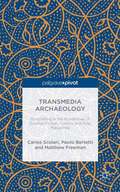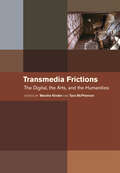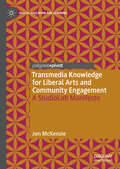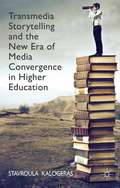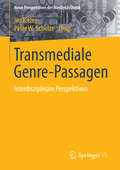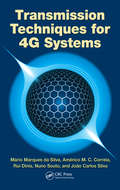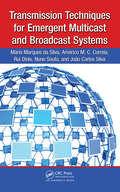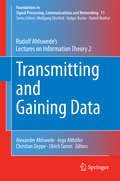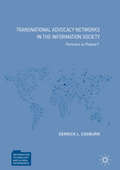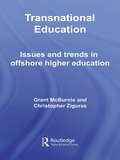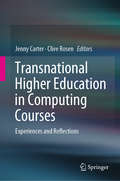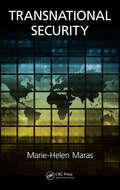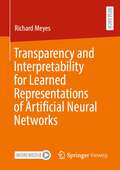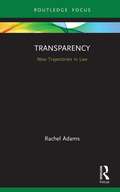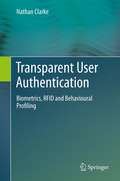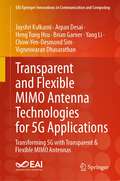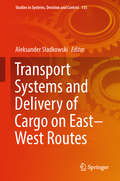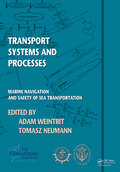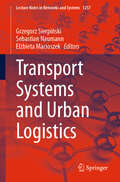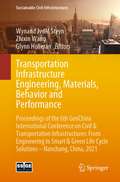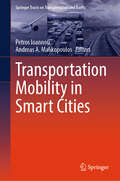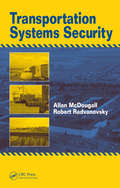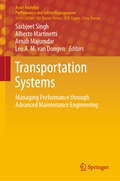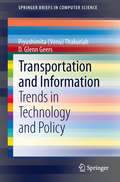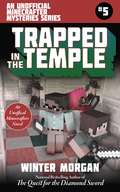- Table View
- List View
Transmedia Archaeology: Storytelling in the Borderlines of Science Fiction, Comics and Pulp Magazines
by Matthew Freeman Carlos A. Scolari Paolo BertettiIn this book, the authors examine manifestations of transmedia storytelling in different historical periods and countries, spanning the UK, the US and Argentina. It takes us into the worlds of Conan the Barbarian, Superman and El Eternauta, introduces us to the archaeology of transmedia, and reinstates the fact that it's not a new phenomenon.
Transmedia Frictions: The Digital, the Arts, and the Humanities
by Marsha Kinder and Tara McPhersonEditors Marsha Kinder and Tara McPherson present an authoritative collection of essays on the continuing debates over medium specificity and the politics of the digital arts. Comparing the term "transmedia" with "transnational," they show that the movement beyond specific media or nations does not invalidate those entities but makes us look more closely at the cultural specificity of each combination. In two parts, the book stages debates across essays, creating dialogues that give different narrative accounts of what is historically and ideologically at stake in medium specificity and digital politics. Each part includes a substantive introduction by one of the editors. Part 1 examines precursors, contemporary theorists, and artists who are protagonists in this discursive drama, focusing on how the transmedia frictions and continuities between old and new forms can be read most productively: N. Katherine Hayles and Lev Manovich redefine medium specificity, Edward Branigan and Yuri Tsivian explore nondigital precursors, Steve Anderson and Stephen Mamber assess contemporary archival histories, and Grahame Weinbren and Caroline Bassett defend the open-ended mobility of newly emergent media. In part 2, trios of essays address various ideologies of the digital: John Hess and Patricia R. Zimmerman, Herman Gray, and David Wade Crane redraw contours of race, space, and the margins; Eric Gordon, Cristina Venegas, and John T. Caldwell unearth database cities, portable homelands, and virtual fieldwork; and Mark B.N. Hansen, Holly Willis, and Rafael Lozano-Hemmer and Guillermo Gómez-Peña examine interactive bodies transformed by shock, gender, and color. An invaluable reference work in the field of visual media studies, Transmedia Frictions provides sound historical perspective on the social and political aspects of the interactive digital arts, demonstrating that they are never neutral or innocent.
Transmedia Knowledge for Liberal Arts and Community Engagement: A StudioLab Manifesto (Digital Education and Learning)
by Jon McKenzieThis book sets forth a pedagogy for renewing the liberal arts by combining critical thinking, media activism, and design thinking. Using the StudioLab approach, the author seeks to democratize the social and technical practices of digital culture just as nineteenth century education sought to democratize literacy. This production of transmedia knowledge—from texts and videos to comics and installations—moves students between seminar, studio, lab, and field activities. The book also wrestles with the figure of Plato and the very medium of knowledge to re-envision higher education in contemporary societies, issuing a call for community engagement as a form of collective thought-action.
Transmedia Storytelling And The New Era Of Media Convergence In Higher Education
by Stavroula KalogerasIn the age of media convergence, stories have morphed into new forms yet their core purpose remains the same, which is to pass on knowledge and information. This book argues that the inherent interactivity of the internet and the emotional engagement of story can lead to innovative pedagogies in media-rich environments.
Transmediale Genre-Passagen
by Ivo Ritzer Peter W. SchulzeGenres unterliegen stets Transformationsprozessen und stehen in Wechselbeziehungen zu anderen Genres - nicht nur intramedial, sondern in einer medienpluralisierten globalen Gesellschaft immer stärker auch medienübergreifend. Daher lassen sich anhand generischer Strukturen auch komplexe mediale und kulturelle Austauschprozesse beobachten und analysieren. Dieser Band fokussiert transmediale Erscheinungen und bietet eine interdisziplinäre Plattform, um verschiedene Forschungsperspektiven miteinander zu verbinden, die sich in Bezug auf Genre-Muster in differenten Medien traditionell eher isoliert entwickelt und auch unterschiedlich konzipierte Terminologien hervorgebracht haben.
Transmission Techniques for 4G Systems
by Rui Dinis Mario Marques da Silva Americo Correia Nuno Souto Joao Carlos SilvaFourth Generation (4G) wireless communication systems support current and emergent multimedia services such as mobile TV, social networks and gaming, high-definition TV, video teleconferencing, and messaging services. These systems feature the All-over-IP concept and boast improved quality of service. Several important R&D activities are curren
Transmission Techniques for Emergent Multicast and Broadcast Systems
by Rui Dinis Mario Marques da Silva Americo Correia Nuno Souto Joao Carlos SilvaDescribing efficient transmission schemes for broadband wireless systems, Transmission Techniques for Emergent Multicast and Broadcast Systems examines advances in transmission techniques and receiver designs capable of supporting the emergent wireless needs for multimedia broadcast and multicast service (MBMS) requirements. It summarizes the resea
Transmitting and Gaining Data
by Ingo Althöfer Rudolf Ahlswedealexander Ahlswede Christian Deppe Ulrich TammThe calculation of channel capacities was one of Rudolf Ahlswede's specialties and is the main topic of this second volume of his Lectures on Information Theory. Here we find a detailed account of some very classical material from the early days of Information Theory, including developments from the USA, Russia, Hungary and (which Ahlswede was probably in a unique position to describe) the German school centered around his supervisor Konrad Jacobs. These lectures made an approach to a rigorous justification of the foundations of Information Theory. This is the second of several volumes documenting Rudolf Ahlswede's lectures on Information Theory. Each volume includes comments from an invited well-known expert. In the supplement to the present volume, Gerhard Kramer contributes his insights. Classical information processing concerns the main tasks of gaining knowledge and the storage, transmission and hiding of data. The first task is the prime goal of Statistics. For transmission and hiding data, Shannon developed an impressive mathematical theory called Information Theory, which he based on probabilistic models. The theory largely involves the concept of codes with small error probabilities in spite of noise in the transmission, which is modeled by channels. The lectures presented in this work are suitable for graduate students in Mathematics, and also for those working in Theoretical Computer Science, Physics, and Electrical Engineering with a background in basic Mathematics. The lectures can be used as the basis for courses or to supplement courses in many ways. Ph. D. students will also find research problems, often with conjectures, that offer potential subjects for a thesis. More advanced researchers may find questions which form the basis of entire research programs.
Transnational Advocacy Networks in the Information Society: Partners or Pawns? (Information Technology and Global Governance)
by Derrick L. CogburnThis book examines the role of transnational advocacy networks in enabling effective participation for individual citizens in the deliberative processes of global governance. Contextualized around the international conference setting of the United Nations-sponsored World Summit on the Information Society (WSIS) in 2003 and 2005, the book sees epistemic communities and information and communication technologies (ICTs) as critical to the effectiveness of this important organizational form. Historically, governments have dominated the official “conference diplomacy” surrounding these World Summits. However, reflecting the UN General Assembly resolution authorizing WSIS, transnational civil society and private sector organizations were invited to participate as official partners in a multistakeholder dialogue at the summit alongside the more traditional governments and international organizations. This book asks: are transnational advocacy networks active in the global information society influential partners in these global governance processes, or merely symbolic tokens—or pawns? Cogburn explores the factors that enabled some networks—such as the Internet Governance Caucus—to persist and thrive, while others failed, and sees linkages with epistemic communities—such as the Global Internet Governance Academic Network—and ICTs as critical to network effectiveness.
Transnational Education: Issues and Trends in Offshore Higher Education
by Christopher Ziguras Grant McBurnieWhile the international mobility of students is a well-established feature of higher education, the international mobility of institutions and courses on a large scale is a more novel phenomenon. Transnational education is at the leading-edge of the most fundamental changes taking place in higher education today. Topics discussed in this new volume include: the extent and form of offshore activity the pedagogical and cultural controversies that have plagued transnational education the challenges it presents to governments, educators and HE managers how governments are developing forms of regulation to integrate cross-border programs and branch-campuses into their strategic planning for the sector the new opportunities for students and institutions. Transnational Education presents a global perspective on the development of international online education, partner-supported transnational programs and international branch campuses. It provides a comprehensive and analytical account of the active role some universities are playing on the international stage and offers valuable guidance on future trends in the sector.
Transnational Higher Education in Computing Courses: Experiences and Reflections
by Jenny Carter Clive RosenThere has been exponential growth in transnational education (TNE) in the last few years as UK universities have looked to expand their markets. Recipient countries have sought short cuts to developing their higher education provision which has proved a lucrative income stream for some universities. But overseas collaborations are not without risk. Recipient countries can be concerned with external influence over curricula, quality being diluted and higher education being infected by neo-imperialism. These concerns are not without foundation. There are risks for providers too. Reputations can be damaged if academic standards are compromised. Conflicts of interest can occur between quality of provision and the pot of gold on offer. Staff can view overseas collaborations as distracting from their research and commitment to home students. Computing is a particularly popular subject for TNE, but critical thinking, analysis, independent learning, and creativity can be compromised. Preventing plagiarism is difficult. Constant changes in technology result in constant curricula revision which causes severe problems for overseas collaborations. This book focuses on TNE in the computing domain. However cross-cultural issues challenge TNE management and administration whatever the subject area. If the ever present tensions are not continuously monitored they can quickly threaten the sustainability of the collaboration. This book identifies many of the threats and some of the solutions. The readership for this book is truly global. Any international development officer in higher education considering an overseas collaboration will benefit from this book. Any academic becoming engaged in, or already involved with a TNE partnership, either as provider or recipient, will gain information and insight into the practice and issues. Researchers in TNE will discover more lines of enquiry. Students considering a course with an overseas provider or in coming to the UK to study will be better prepared thereby enabling a more fulfilling and rewarding experience. Anyone who has an interest in TNE, whether at the senior executive level, operational level, delivering programmes or as a recipient of TNE should read this book. The wealth of experience gathered here will provoke questions, prompt debate and offer solutions. It has been written by people who know the issues, bear the scars and are happy to share their knowledge. It will greatly benefit future transnational collaborations.
Transnational Security
by Marie-Helen MarasGlobalization and the easy movement of people, weapons, and toxins across borders has transformed security into a transnational phenomenon. Preventing transnational security threats has proven to be a very difficult challenge for governments and institutions around the world. Transnational Security addresses these issues, which are at the forefront
Transparency and Interpretability for Learned Representations of Artificial Neural Networks
by Richard MeyesArtificial intelligence (AI) is a concept, whose meaning and perception has changed considerably over the last decades. Starting off with individual and purely theoretical research efforts in the 1950s, AI has grown into a fully developed research field of modern times and may arguably emerge as one of the most important technological advancements of mankind. Despite these rapid technological advancements, some key questions revolving around the matter of transparency, interpretability and explainability of an AI’s decision-making remain unanswered. Thus, a young research field coined with the general term Explainable AI (XAI) has emerged from increasingly strict requirements for AI to be used in safety critical or ethically sensitive domains. An important research branch of XAI is to develop methods that help to facilitate a deeper understanding for the learned knowledge of artificial neural systems. In this book, a series of scientific studies are presented that shed light on how to adopt an empirical neuroscience inspired approach to investigate a neural network’s learned representation in the same spirit as neuroscientific studies of the brain.
Transparency: New Trajectories in Law (New Trajectories in Law)
by Rachel AdamsThis book critiques the contemporary recourse to transparency in law and policy. This is, ostensibly, the information age. At the heart of the societal shift toward digitalisation is the call for transparency and the liberalisation of information and data. Yet, with the recent rise of concerns such as 'fake news', post-truth and misinformation, where the policy responses to all these phenomena has been a petition for even greater transparency, it becomes imperative to critically reflect on what this dominant idea means, whom it serves, and what the effects are of its power. In response, this book provides the first sustained critique of the concept of transparency in law and policy. It offers a concise overview of transparency in law and policy around the world, and critiques how this concept works discursively to delimit other forms of governance, other ways of knowing and other realities. It draws on the work of Michel Foucault on discourse, archaeology and genealogy, together with later Foucaultian scholars, including Gayatri Chakravorty Spivak and Judith Butler, as a theoretical framework for challenging and thinking anew the history and understanding of what has become one of the most popular buzzwords of 21st century law and governance. At the intersection of law and governance, this book will be of considerable interest to those working in these fields; but also to those engaged in other interdisciplinary areas, including society and technology, the digital humanities, technology laws and policy, global law and policy, as well as the surveillance society.
Transparent User Authentication
by Nathan ClarkeThis groundbreaking text examines the problem of user authentication from a completely new viewpoint. Rather than describing the requirements, technologies and implementation issues of designing point-of-entry authentication, the book introduces and investigates the technological requirements of implementing transparent user authentication - where authentication credentials are captured during a user's normal interaction with a system. This approach would transform user authentication from a binary point-of-entry decision to a continuous identity confidence measure. Topics and features: discusses the need for user authentication; reviews existing authentication approaches; introduces novel behavioural biometrics techniques; examines the wider system-specific issues with designing large-scale multimodal authentication systems; concludes with a look to the future of user authentication.
Transparent and Flexible MIMO Antenna Technologies for 5G Applications: Transforming 5G with Transparent & Flexible MIMO Antennas (EAI/Springer Innovations in Communication and Computing)
by Yang Li Jayshri Kulkarni Arpan Desai Heng Tung Hsu Brian Garner Chow-Yen-Desmond Sim Vigneswaran DhasarathanThis book presents a comprehensive and in-depth exploration of the intricate design process and advanced modeling techniques employed in the creation of cutting-edge antenna geometries specifically tailored to meet the demands of Sub-6 GHz 5G wireless applications and communication systems. The authors provide valuable insights into the selection of flexible substrates, which serve as the foundation for the production of versatile antennas capable of seamlessly integrating into the rapidly evolving 5G and MIMO landscapes. Delving into the depths of antenna design, this book highlights the key aspects surrounding flexible MIMO antennas, showcasing their remarkable compatibility within compact spaces. The authors elucidate the intricacies involved in creating these antennas, illuminating their ability to adapt to challenging environmental conditions while maintaining exceptional performance. Furthermore, the authors delve into the fascinating realm of optimized flexible antenna arrays for MIMO systems, employing both transparent and non-transparent materials. The development of such arrays entails a meticulous optimization process, where a delicate balance between performance, form factor, and functionality is achieved. By shedding light on this complex process, the book equips readers with the knowledge and tools necessary to engineer high-performing, flexible antenna arrays for advanced wireless communication systems. The book embraces a broad scope by encompassing various substrate materials and fabrication techniques. This inclusive approach ensures its relevance and applicability to a wide range of readers, including novice researchers, postgraduate students, research scholars, as well as seasoned professionals and experts in the field of antennas hailing from diverse industries and academic institutions. Moreover, undergraduate students pursuing degrees in Communication Engineering, Electronics Engineering, and Antennas for Wireless Communication Systems will find this book to be an indispensable resource, offering highly pertinent and enlightening content that bridges the gap between theoretical concepts and real-world antenna design challenges.
Transport Systems and Delivery of Cargo on East–West Routes (Studies In Systems, Decision And Control #155)
by Aleksander SładkowskiThis book discusses the problems of delivering goods from East and South-East Asia to Europe, presenting the regional transport problems experienced in Italy, Slovakia, Russia, Georgia, Kazakhstan, Uzbekistan and Poland. The book is divided into two parts. The first part is devoted to the analysis of various issues in global logistics and regional transport, which operate in transport corridors. The second part of the book focuses on solutions to some of the technical and informatics problems related to the organization of transportation along the East–West routes. Intended primarily for professionals involved in various aspects of cargo delivery along the East–West routes, the book is also useful for manufacturers, technical staff at logistics companies, managers, students of transport-related subjects, as well as for a wide range of readers interested in the current state of transport in different countries.
Transport Systems and Processes: Marine Navigation and Safety of Sea Transportation
by Adam Weintrit Tomasz NeumannThe TransNav 2011 Symposium held at the Gdynia Maritime University, Poland in June 2011 has brought together a wide range of participants from all over the world. The program has offered a variety of contributions, allowing to look at many aspects of the navigational safety from various different points of view. Topics presented and discussed at th
Transport Systems and Urban Logistics (Lecture Notes in Networks and Systems #1257)
by Elżbieta Macioszek Grzegorz Sierpiński Sebastian NaumannThis book contains an abundance of numerical analyses based on significant data sets, illustrating the close affiliation between mobility and quality of life. What types of solutions can transform an urban zone into a Smart City? What parameters are important in the problem of optimizing supply strategies, especially at last-mile stage? How to use multi-criteria analysis when selecting parking locations? How to examine the condition of infrastructure and what impact it may have on delays in tram traffic? How to combine activities related to the suburbanization process with the integration of tariffs in public transport? This book provides you with answers to these and many other questions. With regard to the research results discussed and the selected solutions applied, the book primarily addresses the needs of three target groups: Scientists and researchers (ITS field) Local authorities (responsible for the transport systems at the urban and regional level) Representatives of business (traffic strategy management) and industry (manufacturers of ITS components). This book gathers selected papers presented at the 20th “Transport Systems. Theory and Practice” Scientific and Technical Conference organised by the Department of Transport Systems, Traffic Engineering and Logistics at the Faculty of Transport and Aviation Engineering of the Silesian University of Technology. The conference was held on 10–11 September 2024 in Katowice (Poland).
Transportation Infrastructure Engineering, Materials, Behavior and Performance: Proceedings of the 6th GeoChina International Conference on Civil & Transportation Infrastructures: From Engineering to Smart & Green Life Cycle Solutions -- Nanchang, China, 2021 (Sustainable Civil Infrastructures)
by Wynand JvdM Steyn Zhixin Wang Glynn HolleranSociety needs to travel to engage in productive and effective commerce, social, educational and related activities. Efficient travel is founded on an operational transport infrastructure system that is well-designed, engineering, constructed and maintained. This volume shares some of the latest innovations and thoughts in the areas of pavement infrastructure materials, behavior and performance. Access to this volume should enable the reader to gain an understanding of such novel information that should support improvements in the provision of an effective road transportation system for the benefit of the greater society served by the road network. The content is based on the contributions to the 6th GeoChina International Conference on Civil & Transportation Infrastructures: From Engineering to Smart & Green Life Cycle Solutions -- Nanchang, China, 2021.
Transportation Mobility in Smart Cities (Springer Tracts on Transportation and Traffic #21)
by Petros Ioannou Andreas A. MalikopoulosThis book covers multiple dimensions of future mobility systems in smart cities, mapping out the innovations that are needed, presenting ideas on how to address the challenges they present and exploring a holistic research path for future developments. The book considers the interaction between: technological developments in modes of transport and transportation systems like autonomous systems and shared mobility that lead to emerging mobility systems; the social behavior of the drivers and travelers who interact with these systems; and the institutional behavior of organized units such as the administrators responsible for the policies involved with transportation governance and regulation. Transportation Mobility in Smart Cities provides methods to analyze, design, and optimize a mobility system, taking into consideration this constellation of social and institutional factors as well as the necessary technological requirements. The result is a mobility system that will be acceptable to travelers without imposing undue inequities in transportation on the smart city. The holistic approach taken in addressing the problems involved with establishing a mobility system within a smart city makes this book attractive to researchers and practitioners, technologists, and policy makers alike. Graduate students working in areas connected with the evolution of transportation systems will also find the material presented in this book instructive.
Transportation Systems Security
by Allan McDougall Robert RadvanovskyHighlighting the importance of transportation to a country‘s infrastructure and survival, Transportation Systems Security presents the strategic and practical considerations involved in the implementation of physical, procedural, and managerial safeguards required to keep all modes of transportation up and running during an actual or potenti
Transportation Systems: Managing Performance through Advanced Maintenance Engineering (Asset Analytics)
by Sarbjeet Singh Alberto Martinetti Arnab Majumdar Leo A. M. van DongenThis book explores the application of breakthrough technologies to improve transportation performance. Transportation systems represent the “blood vessels” of a society, in which people and goods travel. They also influence people’s lives and affect the liveability and sustainability of our cities. The book shows how emergent technologies are able to monitor the condition of the structure in real time in order to schedule the right moment for maintenance activities an so reduce the disturbance to users.This book is a valuable resource for those involved in research and development in this field. Part I discusses the context of transportation systems, highlighting the major issues and challenges, the importance of understating human factors that could affect the maintenance operations and the main goals in terms of safety standards. Part II focuses on process-oriented innovations in transportation systems; this section stresses the importance of including design parameters in the planning, offering a comparison between risk-based and condition-based maintenance and, lastly, showing applications of emergent technologies. Part III goes on to reflect on the technical-oriented innovations, discussing the importance of studying the physical phenomena that are behind transportation system failures and problems. It then introduces the general trend of collecting and analyzing big data using real-world cases to evaluate the positive and negative aspects of adopting extensive smart sensors for gathering information on the health of the assets. The last part (IV) explores cultural and behavioural changes, and new knowledge management methods, proposing novel forms of maintenance and vocational training, and introduces the need for radical new visions in transportation for managing unexpected events.The continuous evolution of maintenance fields suggests that this compendium of “state-of-the-art” applications will not be the only one; the authors are planning a collection of cutting-edge examples of transportation systems that can assist researchers and practitioners as well as students in the process of understanding the complex and multidisciplinary environment of maintenance engineering applied to the transport sector.
Transportation and Information
by D. Glenn Geers Piyushimita Vonu ThakuriahTransformations in wireless connectivity and location-aware technologies hold the promise of bringing a sea-change in the way transportation information is generated and used in the future. Sensors in the transportation system, when integrated with those in other sectors (for example, energy, utility and health) have the potential to foster novel new ways of improving livability and sustainability. The end-result of these developments has been somewhat contradictory. Although automation in the transportation environment has become increasingly widespread, the level of involvement and active participation by people, in terms of co-creation and contribution of information, has also increased. As a result, the following two major trends have been observed: (1) increases in Machine-to- Machine (M2M) communications; and (2) increases in the variety and volume of User-Generated Content. In this transportation paradigm, the pervasive use of Information and Communication Technologies will serve as the foundation for mobility intelligence towards an "ubiquitous information-centered mobility environment". However, many technical and operational questions, as well as social, management and legal challenges present themselves in the transformation to this vision. The book presents a non-technical review of research and initiatives and a discussion of such opportunities and challenges.
Trapped In the Temple (Unofficial Minecraft Mysteries #5)
by Winter MorganAs Edison and Billy’s fame grows, they find themselves sought out by young Princess Hannah. Her pet ocelot is trapped in a luxurious desert temple, and she needs their help to bring her pet home. They accept the job, but quickly discover that there is far more going. When they arrive in the desert, they learn that the whole town has been abandoned, and they have to work with Princess Hannah to find not only her beloved pet, but her friends and family, too!Join Edison and Billy as they travel to the desert to help Princess Hannah in the fifth installment of the Unofficial Minecraft Mystery series!
